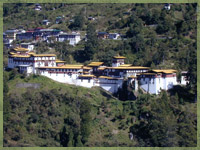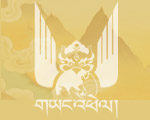 To
review Bhutan's history is to appreciate the continuing importance
of the country's heritage and the ongoing interplay between
the past and the present. The contemporary situation essentially
remains the accumulated product of a long and isolated past.
Significantly, until the modern era there had occurred no major
watersheds, dislocating the country from its previous traditions
and placing it on an alternative trajectory. This design tends
to both reinforce a continuing intimacy and bestow an unusual
degree of continuity. A steady and consistent process of internal
succession is punctuated by four defining moments: the arrival
of Buddhism closely followed by the profound presence of Guru
Rinpoche; the birth of the nation upon unification by Shabdrung
Ngawang Namgyal; the establishment of a monarchy under the First
King Ugyen Wangchuck; and collective integration within regional
and global systems and the beginning of modernization. To
review Bhutan's history is to appreciate the continuing importance
of the country's heritage and the ongoing interplay between
the past and the present. The contemporary situation essentially
remains the accumulated product of a long and isolated past.
Significantly, until the modern era there had occurred no major
watersheds, dislocating the country from its previous traditions
and placing it on an alternative trajectory. This design tends
to both reinforce a continuing intimacy and bestow an unusual
degree of continuity. A steady and consistent process of internal
succession is punctuated by four defining moments: the arrival
of Buddhism closely followed by the profound presence of Guru
Rinpoche; the birth of the nation upon unification by Shabdrung
Ngawang Namgyal; the establishment of a monarchy under the First
King Ugyen Wangchuck; and collective integration within regional
and global systems and the beginning of modernization.
Circumstantial evidence suggests that the land was inhabited
by around 2000BC. Not much is known about these pre-historic
peoples and their cultures or their relationship with the
surrounding regions. The country's demographic history is
however one of ongoing migration, reflected in the chronology
of the three broad ethnic groupings: first the Sharchops of
Indo-Mongoloid origin; then the Ngalops of Tibetan origin;
and more recently the Lhotsams of Nepali origin. Prevailing
community structures - dispersed, localized, agrarian and
self-sufficient - indicate a relative stability in underlying
social and economic conditions. Upon this essentially constant
background is placed an overwhelming and deeply interrelated
religious and political overlay.
Prior to the arrival of Buddhism in the Seventh Century,
communities subscribed to the Bon religion, characterized
by the worship of spirits associated with elements from the
natural environment. The Buddhist religion merged these beliefs
within its broader framework, and through its diffusion became
the first collective authority and cohesive force. Many influential
religious figures either traveled through or made Bhutan their
home. The nation first achieved a degree of political unity
in the Seventeenth Century under the extraordinary leadership
of Shabdrung Ngawang Namgyal, the hierarch of the Drukpa Kagyupa
religious order. He established a centralized theocracy of
intertwined religious and secular rule, simultaneous and somewhat
akin to the Tibetan Gelugpa system under successive Dalai
Lamas.
Until the seventeenth century the country consisted of a
dislocated collection of local fiefdoms ruled by families
of noble descent. The political hierarchy implied by nobility
highlights the intimate relationship between spiritual and
temporal legitimacy. This was further underlined by the Drukpa
theocracy, which provided an initial sense of nationhood even
though it did not achieve continuing secular stability. The
process of internal political unification finally reached
a logical conclusion in the early Twentieth Century with the
introduction of a hereditary monarchy. Having spent most of
its history isolated from significant external influence,
Bhutan became more intimately linked with the modern world
in the early 1960s. This signifies the most far-reaching political
development in the nation's history, as it becomes connected
to the subtle multidimensional powers implied by the modernization
process.
|



